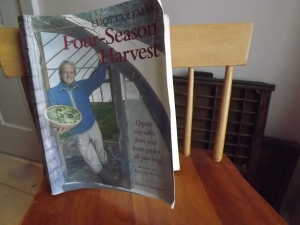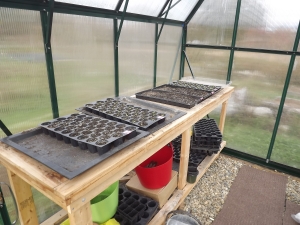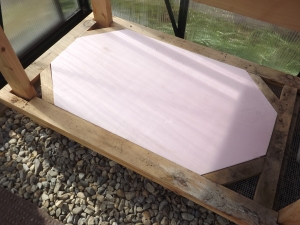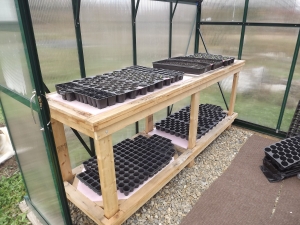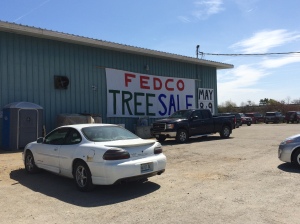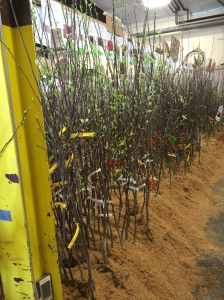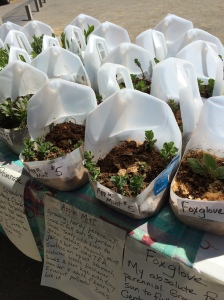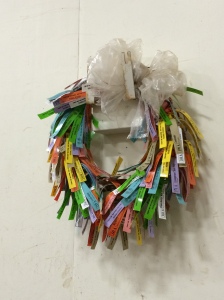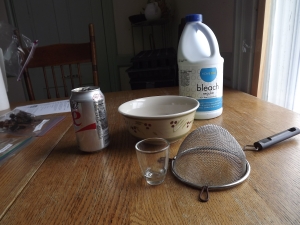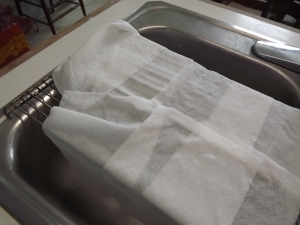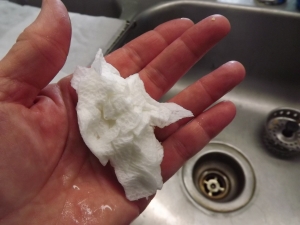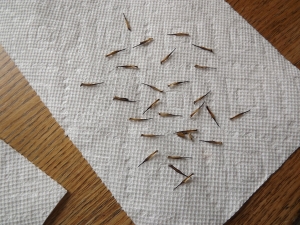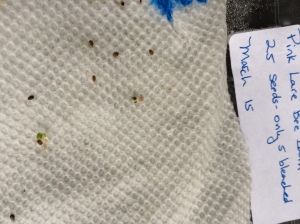Autumn is upon us and winter is coming. That means I’m looking out the windows and loving the burgundies and golds and stubborn greens on the trees. It means I’m reconnecting with the guy that plows our driveway, and I’m annoying Husband by insisting that we drain the hoses and bring the lawn furniture into the basement BEFORE it snows. It also means I’m looking forward to growing food in my greenhouse. Say what?!
Thanks to Eliot Coleman, I think my greenhouse will not just serve as a solarium during the winter. I think it’s going to produce food for us even when the nighttime temperatures dip below -10 degrees. I’m going to take the principles outlined in his “Four-Season Harvest”, and put them into practice. Coleman gardens in Maine. He is the essence of Yankee ingenuity and Maine practicality. He believes in low-tech, in no guilt, in low cost. If I weren’t already married….
The principle of the four-season garden is that you grow plants that are cold hardy, and you start them early enough in the year that they have reached maturity when the frost arrives. In that way, you aren’t growing in the frozen season, but you are still harvesting. The way this is done is to have your plants under multiple layers. He uses hoop houses that then have covered low tunnels inside.
In Coleman’s own words:
“Our four-season harvest is based on a simple premise. Whereas the growing season may be chiefly limited to the warmer months, the harvest season has no such limits. We enjoy a year-round harvest by following two practices: succession planting and crop protection.…only the harvest season and not the growing season, needs to be extended. The distinction is important because the harvest season can be extended with cool-weather vegetables and simple crop protection.”
Coleman states that every layer of protection increases your hardiness zone by 1.5 zones. So, outside my Maine greenhouse it is Zone 5. Inside the greenhouse it is zone 6+ and I’m now in New York. And under the next layer of protection (my covered seed table), it will be Zone 8 and Georgia. Can I grow winter greens in Georgia? I trust Eliot Coleman and so I’ll say yes.
My greenhouse is built on a gravel base, and so I cannot use his low-tunnel technique of planting directly in the ground. What I am doing is using the wonderful seed table Husband built me to hold the seed trays and then covering that table.
I started planting two weeks ago. I chose 4 plants: claytonia (which my Boston-based daughter tells me is on the trendier menus in Boston restaurants!), mizuna, tatsoi, and mache. Here is what that first planting looked like in the greenhouse. Note that I’m only using the top shelf of the table at this point:
Following Coleman’s recommendation of succession planting, I started a second wave of seedlings this past weekend. I was concerned that the wire mesh that forms the surface of the two levels would allow cold air to come up underneath the trays and freeze the seedlings. (Ladies, think of the canyons of New York in January, when you’re wearing a skirt.)
So Husband took some unused pink foam-insulation boards and cut them to size for me. I was working out in the garden, went to the basement workshop to remind him of my desperate need for pink planks, and found this waiting for me outside the garage door:
I emptied both levels on the table, and pushed the foam insulation into place:
Then I set all the seed trays on top of the insulation. Here is the before and after photos of the trays, empty and planted:
Here is what I’m hoping to harvest in about 4 weeks:
Claytonia (montia perfoliata): Coleman says claytonia “should win the winter salad sleeper award for being both unknown and irresistible.” It is also known as “miner’s lettuce.” It is the hardiest of the winter salad crops and it’s so pretty it’s “almost ornamental”. I read that I’m never to thin the plant, but instead I should grasp the leaves and cut the stems below them. By doing this, claytonia keeps producing new leaves throughout the winter.
Mizuna (brassica rapa nipposinica): This is billed as a mild and delicate Oriental plant, with a slight flavor of mustard. It has fringed leaves and I read that it will yield over a long period if it is cut back to encourage new leaf production.
Tatsoi (brassica rapa rosularis): Also known as spinach mustard or rosette bok choy, this is another Oriental vegetable. I hear that it even looks nutritious because of its dark green shiny leaves. It is supposed to survive the coldest weather.
Mache (valerianella locusta): This is also known as corn salad, forming a small rosette of tender leaves. Coleman says, “It is to winter what sweet corn is to summer: a plant adapted to its season. It is the queen of vigor and robustness.” The recommended harvesting technique is to cut the whole plant at soil level and serve it intact in a salad without cutting it up.
Here are two photos of the first seedlings to emerge, on the top shelf: mizuna and tatsoi:
You’ll notice that the plants look identical! That’s because all you’re seeing right now are the cotyledons, the first set of leaves. The plants will differentiate when they push out their first set of true leaves.
What’s next? We bought 4 wire rods yesterday at the hardware store, and Husband is going to drill holes in the top shelf frame of the table. We will bend and insert the rods that will act as wickets. Then I will drape floating row cover cloth over the entire table, securing it with clothespins. Another advantage of planting indoors is I don’t have to worry about wind lifting up the floating cover. Coleman’s book advises having the cloth in place well above the plants, as contact with the plants will allow frost to grab and kill the tender seedlings.
So, Part Two of this post will be the installation of the wire wickets and the floating cloth. Photos will accompany, and hopefully I will have photos of the emerging plants to share with you soon!
